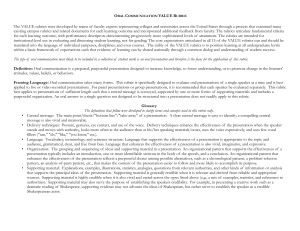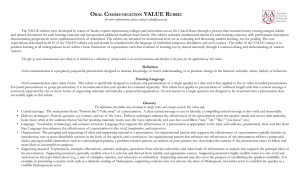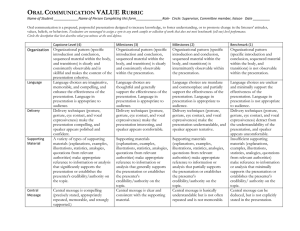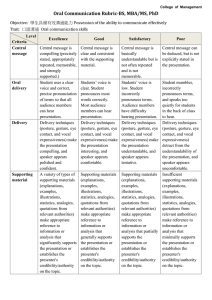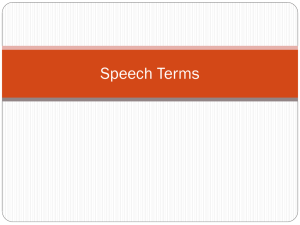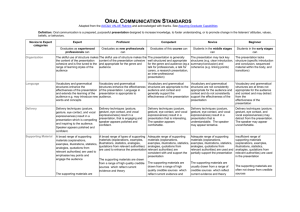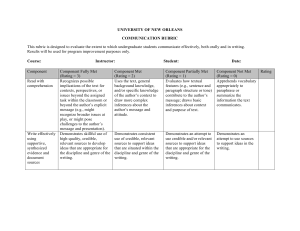Document 15090161
advertisement
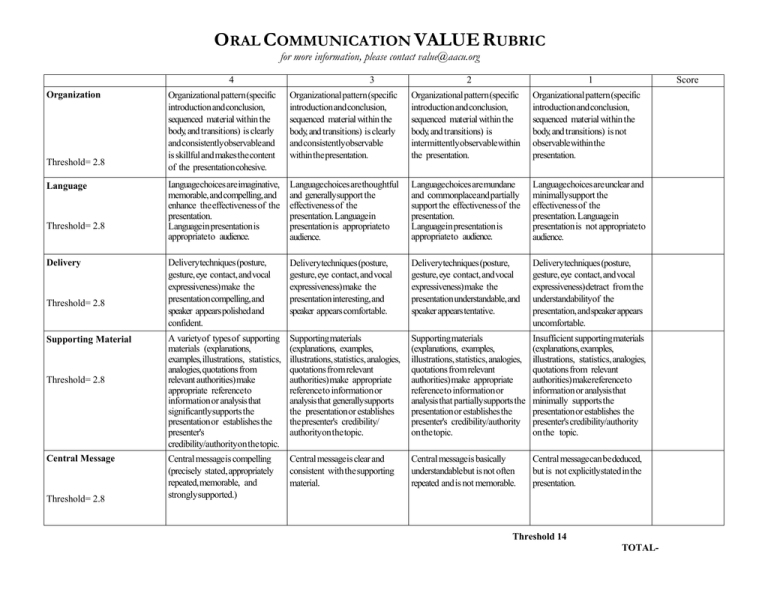
ORAL COMMUNICATION VALUE RUBRIC for more information, please contact value@aacu.org 4 Organization Threshold= 2.8 Language Threshold= 2.8 Delivery Threshold= 2.8 Supporting Material Threshold= 2.8 Central Message Threshold= 2.8 3 2 1 Score Organizational pattern (specific introduction and conclusion, sequenced material within the body, and transitions) is clearly and consistentlyobservableand is skillful and makes the content of the presentation cohesive. Organizational pattern (specific introduction and conclusion, sequenced material within the body, and transitions) is clearly and consistentlyobservable within the presentation. Organizational pattern (specific introduction and conclusion, sequenced material within the body, and transitions) is intermittentlyobservable within the presentation. Organizational pattern (specific introduction and conclusion, sequenced material within the body, and transitions) is not observable within the presentation. Languagechoices are imaginative, memorable, and compelling, and enhance the effectiveness of the presentation. Languagein presentation is appropriateto audience. Languagechoices are thoughtful and generallysupport the effectiveness of the presentation. Languagein presentation is appropriateto audience. Languagechoices are mundane and commonplaceand partially support the effectiveness of the presentation. Languagein presentation is appropriateto audience. Languagechoices are unclear and minimallysupport the effectiveness of the presentation. Languagein presentation is not appropriateto audience. Deliverytechniques (posture, gesture, eye contact, and vocal expressiveness) make the presentation compelling, and speaker appears polished and confident. Deliverytechniques (posture, gesture, eye contact, and vocal expressiveness) make the presentation interesting, and speaker appears comfortable. Deliverytechniques (posture, gesture, eye contact, and vocal expressiveness) make the presentation understandable, and speaker appears tentative. Deliverytechniques (posture, gesture, eye contact, and vocal expressiveness) detract from the understandabilityof the presentation, and speaker appears uncomfortable. A varietyof types of supporting materials (explanations, examples, illustrations, statistics, analogies, quotations from relevant authorities) make appropriate referenceto information or analysis that significantlysupports the presentation or establishes the presenter's credibility/authorityon the topic. Supporting materials (explanations, examples, illustrations, statistics, analogies, quotations from relevant authorities) make appropriate reference to information or analysis that generallysupports the presentation or establishes the presenter's credibility/ authorityon the topic. Supporting materials (explanations, examples, illustrations, statistics, analogies, quotations from relevant authorities) make appropriate reference to information or analysis that partiallysupports the presentation or establishes the presenter's credibility/authority on the topic. Insufficient supporting materials (explanations, examples, illustrations, statistics, analogies, quotations from relevant authorities) makereference to information or analysis that minimally supports the presentation or establishes the presenter's credibility/authority on the topic. Central messageis compelling (precisely stated, appropriately repeated, memorable, and strongly supported.) Central messageis clear and consistent with the supporting material. Central messageis basically understandablebut is not often repeated and is not memorable. Central messagecan be deduced, but is not explicitlystated in the presentation. Threshold 14 TOTAL- The type of oral communication most likely to be included in a collection of student work is an oral presentation and therefore is the focus for the application of this rubric. Definition Oral communication is a prepared, purposeful presentation designed to increase knowledge, to foster understanding, or to promote change in the listeners' attitudes, values, beliefs, or behaviors. Framing Language Oral communication takes manyforms. This rubric is specifically designed to evaluate oral presentations of a single speaker at a time and is best applied to live or video-recorded presentations. For panel presentations or group presentations, it is recommended that each speaker be evaluated separately. This rubric best applies to presentations of sufficient length such that a central message is conveyed and supported by one or more forms of supporting materials and includes a purposeful organization. An oral answer to a single question not designed to be structured into a presentation does not readilyapplyto this rubric. Glossary The definitions that follow were developed to clarify terms and concepts used in this rubric only. • Central message: The main point/thesis/"bottom line"/"take-away" of a presentation. A clear central message is easy to identify; a compelling central message is also vivid and memorable. • Delivery techniques: Posture, gestures, eye contact, and use of the voice. Delivery techniques enhance the effectiveness of the presentation when the speaker stands and moves with authority, looks more often at the audience than at his/her speaking materials/notes, uses the voice expressively, and uses few vocal fillers ("um," "uh," "like," "you know," etc.). • Language: Vocabulary, terminology, and sentence structure. Language that supports the effectiveness of a presentation is appropriate to the topic and audience, grammatical, clear, and free from bias. Languagethat enhances the effectiveness of a presentation is also vivid, imaginative, and expressive. • Organization: The groupingand sequencing of ideas and supporting material in a presentation. An organizational pattern that supports the effectiveness of a presentation typically includes an introduction, one or more identifiable sections in the body of the speech, and a conclusion. An organizational pattern that enhances the effectiveness of the presentation reflects a purposeful choice among possible alternatives, such as a chronological pattern, a problem-solution pattern, an analysis-of-parts pattern, etc., that makes the content of the presentation easier to followand more likelyto accomplish its purpose. • Supporting material: Explanations, examples, illustrations, statistics, analogies, quotations from relevant authorities, and other kinds of information or analysis that supports the principal ideas of the presentation. Supporting material is generallycredible when it is relevant and derived from reliable and appropriate sources. Supporting material is highly credible when it is also vivid and varied across the types listed above (e.g., a mix of examples, statistics, and references to authorities). Supporting material may also serve the purpose of establishing the speaker’s credibility. For example, in presenting a creative work such as a dramatic reading of Shakespeare, supporting evidencemaynot advance the ideas of Shakespeare, but rather serve to establish the speaker as a credible Shakespearean actor.
